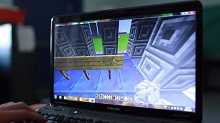I love to listen to a teacher’s passion for teaching others. Passion burns hot until others extinguish the flames. Currently, I’m hearing ,”If we only had this or didn’t have to do that, we could reach the students.” I love to hear students excited about what they are learning in schools. From them, I currently hear, “This common core stuff is too much and no one knows what they are doing.”
I’m here to encourage you. BE BOLD! CREATE! TEACH WHAT WORKS! DEVELOP YOUR OWN LEARNING COMMUNITIES! Follow the standards as we need common standards. Educations needs to have the basis for what should be taught to most children at specific readiness point, but let’s move forth with what we know. Children are sponges until they aren’t. Teachers are excited until they are not. We need to catch both while the fire is hot! There is no time to waste.
Common Core carries a very poor connotation for something I believe we all really want to see happen. Common curriculum across the United States in order that everyone have an equal opportunity for learning. How did it get so blown out of whack in the eyes of teachers, parents and students? If your child was moving from California to Florida as a third grade student, wouldn’t you want your child to be “on the same page” when they move to the new school? I think yes! Now what is good for the mass doesn’t mean that is all that should be available. We still need to build in a support system for those with learning disabilities or a gap in their learning. We also need to provide fun, engaging opportunities for those that are ahead of the game. I believe in flexible grouping based on a students previous knowledge and the learning goal, not necessarily based on age.
The other aspect of Common Core is to create connection between the learning and real-life problem solving. Simply relate what you are teaching to how it will be seen in life. Another aspect of Common Core is to teach to all the modalities by using hands-on approach to reach auditory, visual and kinesthetic modes. Remember that no one has stated what or how teaching needs to be done at this point except the your own districts.
So, how do we get the fun and learning back into the classroom but stay on track? Use your freedom at this time period to find the joy of the teaching/learning process for your students. As your break approaches, look into ideas that will rekindle your flames and light the students back up! Consider something like Whole Brain Learning, AIMS, College Prep Math, STEM or STEAM, Pinterest…
Following are some ideas to get your creative juices flowing:
Three basic techniques in whole brain teaching
The class yes, the teach OK and the scoreboard
It is fundamentally the same type of relationship that would exist, at that moment, between the CEO of Pepsico and the CEO of KFC. (Pepsi owns KFC and I assume KFC takes direction form the parent company). The technique can be understood as a brain switch which readies the students for instruction. In Whole Brain teaching classrooms it is used whenever the teacher needs the class’s attention, which is of course quite often. This technique, like almost all WBT techniques,can be used from kindergarten to university and with adult classes. With children in addition to being a “brain preper” for instruction it an indispensable tool for classroom management.
TECHNIQUE TWO: THE “TEACH- OK” – TEACHING ISN’T JUST FOR TEACHERS
Some of us may have come to Thailand just a bit unclear on the differences between the Present Perfect and Past Simple tenses, or between First and Third Conditional. I know I did. I also know that I could now tell you about fundamental English grammar in my sleep and I am sure, at least hope, that everyone reading this who has taught English for a few years can as well.
How did you learn this grammar so thoroughly? . You did it by teaching. This is the main idea behind the next crucial technique of WBT- the “TEACH-OK”. Research has shown, not surprisingly really, that students learn best when actively engaged in the teaching process. When students , using energetic gesturing, reteach to their partner what the teacher has just taught them they are activating five parts of the brain important to learning : the visual cortex (seeing gestures), motor cortex (making gestures), Broca’s area (verbalizing), Wernickes area (hearing) and the limbic system (giving emotional content). I will number the steps of the “”TEACH OK” to hopefully make it easier to understand and use.
STEP ONE – Divide your classes into pairs. You will want to group weaker students with stronger ones. I think two is the ideal number but if you have an odd number of students you will have to have at least one group of three. In this case put the best student in the class with the two who need the most help and ask the best student to take special care of the group. I have found that at first you may need several groups of three students if stronger students are hard to come by. However as time passes and you continue to implement WBT, you will see a more uniform level in your students ability. This is due to the fact you will be getting almost 100 per cent participation and the students lagging behind will begin to catch up with the others.
STEP TWO – Micro teach with gestures. This means giving one small bit of information that the students will reteach to each other. It requires the teacher to be animated and use gestures as he or she teaches. As an example, if we were teaching the Present Perfect, the teacher would begin the process by introducing a very small bit of information such as “We form the present perfect with have or has.” After the students have learned this small bit of information you build on this idea. The following TEACH-OK segment would be ” We form the present perfect with have or has and verb three.”
We continue building so on and so forth until all the rules of present perfect have been taught or at least all the rules that we wish to cover . If this were a very advanced class the final installment of our look at the present perfect would finally build to up to the studetns teaching each other in pairs something like” The present perfect is formed with have or has plus verb three. It is used for both unfinished actions from a specific time in the past which are continuing into the present and with finished actions that have a relevance to present circumstances. Although it is used exclusively with already, just and yet in British English, these words can be be used correctly with both the Present Perfect and the Simple Past in American English.” I have used an extreme example here of a final “TEACH OK” mini lesson on the Present Perfect to make my point that we build to whatever level the dictates of the course demand, as opposed to giving a lot of information at once.
STEP THREE – To recap steps one and two-we have divided the class into pairs and presented a small bit of information . Now it is time for the teacher to say TEACH! and his/her hands clap hands and have the students respond in the same tone of voice with the same number of claps with an OK! They then work with their partner taking turns reteaching what was just presented. the students are expected to use gestures as they teach each other.
STEP FOUR – The teacher monitors the groups as the students teach each other.
STEP FIVE – The teacher brings the “TEACH-OK” to a close with a “CLASS-YES”
STEP SIX – The teacher then continues with another bit of information building on the previous bit of information, or if it is time, change activities.
Two other valuable tools which are often used during the presentation of a micro bit of information are the “HANDS AND EYES” and “MIRRORING.” These are related but separate techniques that will be elaborated on at a later date that augment the effectiveness of the presentation of information. If you just cant wait for the next blog visit www.powerteacher.net for an immediate explanation.
I have not found a lot of information about EFL and WBT, although it is certainly being used for teaching foreign languages. In my past training I found an emphasis on getting students to use the language creatively. I have certainly done this in the context of WBT. Since I work with phratom students now the steps to creativity are very small but they are creative nonetheless.
For example during the presentation of information I may want the kids to practice using the question word “where.” I may drill the class as a whole by asking students a question like “Where is the dog?” trying to get them to think of places a dog might be. Often times kids will come up with something really silly like “The dog is on the sun.” I love this kind of response. It shows they have used the language creatively. In fact a kid told me when asked once “The dog is on the sun.” I quickly joked back with the question “Is he a hot dog?” and pretty much everybody got the joke.
That really shows that language acquisition was taking place with a group of phratom two students. Think about the implications of that- Phratom two students involved in the creation of and appreaciating a double entendre. Thats the power of Whole Brain Teaching at work. After the good laugh about the” hot dog on the sun” the kids were coming up with wacky places the dog was. During their ” TEACH OK”segment of “Where is the dog?” they seemed to be trying to outdo their partner with the craziest place a dog could be. This is proof of being able to use the language creatively which means real learning is taking place.
TECHNIQUE THREE: “THE SCOREBOARD” – KEEP THE TEACHER HAPPY AND EVERYTHING IS SABAI.
The scoreboard is a central feature of the Whole Brain Teacher’ s classroom. It is an integral part of class management when working with younger students and is critical in keeping older students focused. It basically operates on good ole positive and negative reinforcement. It is simple to understand and use.
STEP ONE – On one side of the whiteboard draw a “Smiley face” next to a “Happy face.”
STEP TWO – Draw a line between the two faces creating a column under each face.
STEP THREE – When students are paying attention, and paricipating with gestures and you are happy with the way things are going put a check in the Smiley face column and have them cheer your approval by saying an enthusiastic “OH YEA” in unison (known as ‘the “MIGHTY OH YEA”).
STEP FOUR – When student performance/behavior is not up to par put a check under the the Frowny face and have the students moan a a collective “OH NO” while wiping away an imaginary tear.
STEP FIVE – At the end of class add up the checks under the respective faces. More checks in the Happy face column means the class has earned some kind of reward (I usually use less homework as a reward) More checks under the frown face means a negative reinforcement (for me more homework).
IMPORTANT NOTE! Do not have a total of more than three checks in in the Frowny face column in excess of the number in the Smiley face otherwise the “SCOREBOARD” loses effectiveness. Students become resentful and lose interest in the “game.”
The “SCOREBOARD” works on the limbic system which is the part of the brain that controls emotional response. It is a powerful tool to keep order and keep things focused. In follow up blogs I will discuss “THE FIVE CLASSROOM RULES” which for the most part are used for class management issues with kids. The rules obviously relate closely to the “SCOREBOARD”. Remember though the “SCOREBOARD” is also used with older students to keep focus.
If I were teaching up university anywhere in the world I would have no qualms about using the “SCOREBOARD” as a fun way to give the class feedback about how well they were performing . That being said I would feel a little foolish walking into a corporate training class anywhere but sanook loving Thailand and drawing a Smiley face and Happy face on a whiteboard in front of a group of business executives and telling them to give me a “MIGHTY OH NO”.
I have taught all kinds of classes here in Thailand as well as a lot of corporate classes . Although I have not had the opportunity to use WBT in a corporate situation, my guess is all Thai students would play along with “THE SCOREBOARD.” Having been witness to a teacher leading a group of bank managers in a game of “Simon Says” I gotta figure you are on safe ground with “THE SCOREBOARD” in any class in Siam. (Simon says touch your butt hahahahah….true story).
These are the three most important techniques in WBT. Just these three simple things can greatly enhance your students learning as well as making your job a helluva lot easier and more enjoyable. There is a lot more to WBT but this can get you started.
Finally I want to underscore that these techniques are flexible and can be used in harmony with your own style and class goals/level. That is unless sadly you have an “I don;’t really give a damn” attitude. I think it is more easily adapted to animated lively styles of teaching but I personally think there is room for those of a more phlegmatic nature, however gestures must be used.
You look at professional athletes, say in a sport like golf or tennis, you will see that the pros are all pretty much adhering to the same set of fundamentals to swinging a club or racket. In spite of this commonality each player has his own unique swing. In the same way each teacher will have his own style in which he can adapt a given pedagogical approach to be the most effective teacher he or she can be.
It is my stalwart conviction that Whole Brain Teaching (or in our case here in Thailand “Ajarning”…lol..) is by far the most effective approach to accomplish this goal. Give WBT a try, you’ll love it and so will your students. Again to find out more about WBT visit the powerteachers website
Happy teaching!
Here is where a creative teacher brought the popular game of Mine Craft into his math lessons.
6 Minecraft lesson ideas for your Common Core math class
From graphing paper to algebra puzzles, one teacher shares tons of practical lesson ideas for turning math class into “Mathcraft”
 Last year I taught third-grade math in a whole new way. Combining elements from the wildly popular sandbox game Minecraft, I had students thinking visually and creatively about mathematical models and theories that went way beyond a typical third-grade curriculum, transforming math class into what I like to call Mathcraft.
Last year I taught third-grade math in a whole new way. Combining elements from the wildly popular sandbox game Minecraft, I had students thinking visually and creatively about mathematical models and theories that went way beyond a typical third-grade curriculum, transforming math class into what I like to call Mathcraft.
Why Minecraft? I could say I am using Minecraft for a number of reasons, like how I find Minecraft enhances metacognition by increasing students’ memory storage capacity. The game itself creates a relatable enjoyable experience that can be internalized and shared in a community of learners. The limitations on the working memory are minimized because the gameplay itself is an extension of our visual sketchpad. Working with students they always say, “I can see it,” and when they see it they share it.
However, the real reason I use Minecraft is that the students chose it. The popularity of the game is so overwhelming and when the lesson became the engagement their attention, confidence, and motivation soared. Here are six great ways to use it in your math classroom.
1. Let students create their world.
If you have an aggressive Minecraft class, you can put them in a single world and either let them all build it by themselves, or allow all the students to build a world together. Personally, I just open up a world in MinecraftEDU (which makes it easier for the teacher since you can do things like freeze the students and transport). I don’t use worlds that have already been created, opting instead to let the kids build their own. I use MinecraftEDU as my server runner and open up the superflat world. We start building and we end up with a crazy math city.
2. Create your own visual, conceptual math world.
I’ve tried to use base ten blocks before because they’ve got a lot of great conceptional knowledge, but they’re just a nightmare to use—to get them to fit in and take out, and with the kids always messing up each other’s blocks. But with Minecraft, the blocks are digital so the kids can’t mess each other up, if you know how to manage them, and the bonus is that the students are incredibly engaged. Then you can throw in the fun part. You can let them PvP (fight) and chase each other in their world. The structures they’ve just made make a lot of fun things to hide behind, like funky-looking trees based on prime factorization or stacks of blocks in patterns that represent long division. It’s kind of a conceptual math world.
3. You can use Minecraft, even without access to computers.
We were only able to play Minecraft in the computer lab twice a week but that was perfect because I just ran math class using Minecraft as the lesson on those days. On other days, we’d be doing similar things. The kids would have graphing paper and would make their models with colored pencils and crayons and we would play math. I was really trying to teach them how to read and write algebra and to look at math as a different language.
4. Minecraft is just one creative tool in the toolbox.
In my third-grade class, we did a lot of tracking and graphing slopes, and I turned it into a maker activity as well. We learned how to read rise over run, and how to build a slope in Minecraft. Then we chopped up a bunch of different cardboard boxes and made racecar ramps at different slopes around the classroom, and ran averages on how far the racecar would travel with each slope—and this was a third-grade classroom.
5. Let the dog drive—at least sometimes.
One way to get started is just to try a whole class lesson and to see how the kids respond to it. And be prepared to let the dog drive at times—meaning when the class is playing the game, let them take control and just play. Give them their time but take yours as well. If you need a jumping-off point to get started, look for Minecraft lessons online, or see mine on the website Educade. The Parthenon lesson I created is one example. It turns algebra into a puzzle and it gives students simple instructions on how to build something cool. (There’s also a video that explains why the formulas actually work).
6. Use Minecraft to help change your classroom culture into something students love.
By far the greatest effect Minecraft has had on my students was a change in the classroom culture and attitudes about education. When we were preparing for our benchmark test I gave them ten Common Core word problems for homework. When I put them on our Edmodo page, they got mad at me. Mathcraft—at least the way I use it in the classroom—is not all in a video game. There is a lot of reading and writing of algebra and word problems. Before, they used to complain and give up when they had to do similar problems out of textbook. But now my kids turned even that part of the curriculum into a game and can not put down the pencil.
Jim Pike formerly taught third grade at Ascension Catholic School in Los Angeles. He currently teaches a Mathcraft course at CodeRev Kids Learning Center in Santa Monica, CA, and is working on bringing Mathcraft professional development to teachers using online Minecraft servers.
Frozen-inspired coding is a very creative idea to hook students into their learning:
‘Let it Code’ with Frozen-inspired coding
Hour of Code initiative aims to help students, especially girls, get coding with real-world examples
 On Nov. 19, Code.org unveiled a computer science tutorial featuring heroines Anna and Elsa from The Walt Disney Company’s film “Frozen.” The tutorial kicks off the second annual Hour of Code campaign, a worldwide effort to broaden participation in computer science – especially by girls – during Computer Science Education Week, Dec. 8-14, 2014.
On Nov. 19, Code.org unveiled a computer science tutorial featuring heroines Anna and Elsa from The Walt Disney Company’s film “Frozen.” The tutorial kicks off the second annual Hour of Code campaign, a worldwide effort to broaden participation in computer science – especially by girls – during Computer Science Education Week, Dec. 8-14, 2014.
Thanks to Disney Interactive, students will learn to write code that enables Disney Infinity versions of Disney’s “Frozen” characters Anna and Elsa to draw snowflakes and snowmen and perform magical “ice craft” in Code.org’s signature lesson for the Hour of Code 2014. The tutorial aims to teach logic and math and nurtures creative thinking through introductory computer programming.
Role-model technologists and celebrities, including Polyvore CEO Jess Lee, Microsoft engineer Paola Mejia, app developer and model Lyndsey Scott, and model Karlie Kloss, provide short video lectures to guide students through the one-hour activity. Students will be able to share their artwork online or with friends through a unique link.
“As a parent, I know firsthand how excited kids are over Disney’s ‘Frozen,’” said Hadi Partovi, co-founder of Code.org. “Our entire team is grateful for Disney Interactive’s tireless support of the Hour of Code, which provides students an entry point into the world of creativity that opens up when they build technology for the first time.”
“Disney Interactive shares Code.org’s passion to unleash the creative potential within all of us and we’re proud that the Disney characters will help children grow and learn important skills,” said Jimmy Pitaro, president of Disney Interactive. “Computer science and coding literacy are vital to our children’s future and we applaud Code.org for making computer science education more widely available.”
Along with this collaboration, Disney is donating $100,000 to support Code.org’s efforts to bring computer science education to afterschool programs nationwide. Disney Interactive will host Hour of Code events for local students at their Los Angeles, Palo Alto, Seattle, and Kelowna, British Columbia offices.
The tutorial, “Artist with Anna & Elsa,” is Code.org’s newest addition to its online learning platform, Code Studio, designed to teach students the basics of computer science, starting as early as kindergarten. Code Studio is used in more than 50,000 classrooms.
Last year, Code.org launched the Hour of Code with a tutorial featuring artwork from Rovio’s Angry Birds, PopCap Games’ Plants vs. Zombies and video lectures by Mark Zuckerberg and Bill Gates. To date, 22 million students have tried the one-hour, introductory tutorial.
Students and teachers can try “Artist with Anna & Elsa” now at Code Studio: code.org/frozen.
Here’s another blogger sharing how Whole Brain Learning works for her:
http://www.teachingandlearningtogether.com/whole-brain-teaching.html
Here are ideas on pinterest of Whole Brain Learning:
http://www.pinterest.com/rbiondo/whole-brain-learning/
Happy planning! Happy teaching! Happy learning!
ENJOY!
~Sandy























